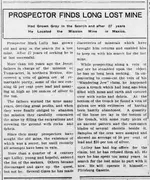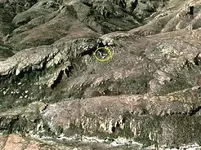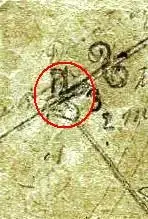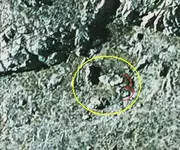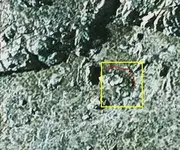Extra coffee alert - long reply, I ask your indulgence. 
Cactusjumper wrote
All,
As I have said before, I'm not debating what took place with the Jesuits in South America, Japan or any of the other places they hung their hats. I'm also not offering an opinion on the different plots and intrigue's they may have been involved in. My own research, for the most part, has been focused on Mexico and in particular the northern portion of that country.
I don't rely on just Jesuit writings. I have given consideration to other sides of the debate including my good friend's Roy,Don Jose and Mike, as well as many others. It's possible that the Jesuits were involved in serious mining in Northern Mexico, but I have not seen any evidence that convinces me it happened.
I would be more than happy to see such hard evidence.
How are the Jesuits of northern Mexico, a separate and distinct organization from the Jesuits of central Mexico? Or of the Jesuits in Spanish America? Are they not all a part of the Society of Jesus, with headquarters in Rome? Why do the Jesuits report to superiors in Mexico city, Spain and Rome, if they are not all one organization? I cannot see that the Jesuits of Sonora, or Sinaloa or Japan are distinct from the Jesuits elsewhere. What is the main purpose of the missions named The Rectorship of Santos Mártires del Japón? Is not the purpose of those missions to generate income to support Jesuit operations in Japan? Why was father Kino and others sent to explore northwest Sonora, trying to find a land route to California, where all of Baja was not just under the parochial care of Jesuit priests but actually ruled by them? Why did Spain wish to have sea ports in California at all, if not to support operations all the way across the Pacific in the Philippines? I can not see that they are disconnected at all, in fact quite the opposite seems to be the case.
I hate to keep re-posting some of this material but perhaps it was forgotten or missed in the lengthy discussion.
"In at least one documented case, the relationship between missionaries and miners in connection with food supply resulted in a singular activity on the part of the priests. Mining in sonora was not limited entirely to lay Spaniards. The Jesuits of Matape mission also engaged in the extraction and refining of silver ores from deposits near Tecoripa, not far from San Miguel Arcangel. According to the rules of the Jesuit order, priests were forbidden to own, operate, or even knowledge of mining. But apparently ownership of the mines in question had been signed over to the mission by a Spanish miner in payment for debts he incurred for supplies obtained from the padres. Moreover, the priests claimed that the mines belonged to the College of San Jose at Matape, not to the mission itself, and thus the superiors permitted continuation of the "forbidden" activity. During the late seventeenth century, annual proceeds from the Tecoripa mines under church management ranged from three thousand to twelve thousand pesos, a substantial windfall for the college and the missionaries. "
<Sonora: its geographical personality by Robert Cooper West, pp 62>
This happens to be the same area where African slaves were first introduced, and the mines so glaringly omitted by father Nentvig; is this the only case where a Jesuit college held title to mines? The college of San Jose and the silver mines of Tecoripa are in Sonora BTW.
"Some capital was also placed in non-agricultural enterprises. The most significant were the mines which provided the sole support of the college of Zacatecas.<snip>
This occurred, for example, in the case of the mines belonging to the college of Zacatecas. The assessors appraised them in 1773 and gave them a value of 365,000 pesos but because of renewed vigor in the mining industry in Zacatecas, the officials conducted a reappraisal in 1780 and increased their value to 730,000 pesos."
<The Wealth of the Jesuits in Mexico, 1670-1767 Author(s): James D. Riley; Source: The Americas, Vol. 33, No. 2 (Oct., 1976), pp. 226-266 Published by: Catholic University of America Press on behalf of Academy of American Franciscan History pp 243, 245>
Did you catch it? Riley tells us that the college of Zacatecas sole source of income was its MINES. The mines mentioned by Mr West, are not the same mines - they belonged to the college of San Jose at Matape! This means there are at least two documented cases of Jesuit colleges which owned and operated MINES. Whom do we think was doing that labor, in those mines? Hired Spanish workers, or do you think perhaps it could have been the local Indios?
Just for good measure, I will add this - the author James Riley also stated, quote
"The Jesuits had three kinds of investments, urban rental property, interest bearing notes, and commercial ventures such as haciendas, mines, obrajes and retail stores which they exploited themselves."
<ibid, pp 242>
Father Polzer mentioned two instances where priests were "caught mining" and never gave any details on these instances; he adds that they were punished, which implies that this mining was for personal gain and not for the Order or Church.
Father Juan Nentvig's Rudo Ensayo describes Sonora circa 1760s period; he lists the Spanish mining settlements in their own chapter, and the Jesuit missions in a separate chapter. A number of these missions also list mines with them. An example:
From Tucson we must trek thirty leagues south to reach the royal presidio of Tubac where we can rest and then proceed to Tumacacori, one league south, and then to Calabazas;40 both are dependent missions of Guebavi,41 the main mission located at 32 degrees, 28 minutes latitude by 263 degrees, 12 minutes longitude. It is administered by Father Custodio Jimeno who is also in charge of the dependent missions. These are Sonoitac, ten leagues to the northeast; Calabazas, four leagues to the north; and Tumacacori, seven leagues to the northwest. There was a fourth mission: Aribaca, twelve leagues to the northwest, that was destroyed in the 1751 uprising. There are several silver mines and one gold mine in the vicinity of Guebavi, but they are not being worked.
Rudo Ensayo, pp 99, available online at:
The Jesuit Missions
Who or whom do you say was the owner of the several silver mines and one gold mine in the vicinity of Guevavi mission? If it were Spaniards, should it not be listed as owned by Spaniards, as Nentvig made it a point to specify when such was the case?
Do you recall father Segesser's letter in which he complained of not having as much funds as desired, in part due to the fact that
he could not work the mines as he might, due to the danger of hostile Indians? Why would he have said that, if he had NO mines to work? Remember, Segesser was stationed at San Xavier del Bac, which he described as in the "silver mountains" and yet had little silverware for eating and cooking.
This recap was posted several years ago:
**The Jesuit California Mission Fund owned mines
The Jesuit college of Zacatecas owned mines
The Jesuit college of San Jose of Matape owned mines
The Jesuit college of Leon, purchased the Mina de los Remedios in 1731**
Father Polzer admitted of two instances in which priests had become involved in mining
The mining registry of Cananea reportedly shows mining started there by Jesuits
Pozos proudly displays their Jesuit furnaces and treasure blockhouse
Father Och told the story of his bit of placer copper mining
The Jesuits were in many instances the pioneer prospectors of the frontier regions
**<source Wealth of the Jesuits in Mexico, cited in previous post>
I think we have posted a number of sources that attribute mines to the Jesuits, and stating the Jesuits were the pioneer miners of the southwest. Would it serve any purpose to repost that information? Lt. Sylvester Mowry stated there were over 100 named mines documented in what became Arizona, but a handful of these mines have ever been re-discovered. We no longer have those documents but perhaps they might turn up some day.
Mounds of smelter slag were found at Tumacacori and Guevavi, and slag is found in the very walls of the Franciscan structures at Tumacacori and San Xavier del Bac. The only source with any info on how much precious metals in that slag indicated that the original ore must have been very rich indeed for the waste material to contain enough values to make it pay to reprocess.
Then there is the Inventory of Tayopa, mentioned and discussed at length some time ago; this document was found by Henry O. Flipper, the first African American to graduate from the United States Military Academy at West Point in 1877, earning a commission as a 2nd lieutenant in the US Army. Some of our skeptics have dismissed the document as a fraud or a hoax, which is calling Flipper a liar and fraud. I am convinced that this document is indeed the genuine article, an actual Church record. Even the date on it points to a time period when such an inventory would likely have been done, possibly at the instigation of bishop Palafox, whose struggle with the Jesuits we have also debated at length some time ago.
In this document alone we have a fair proof of a massive treasure, one which we have no record of it ever being shipped out of Mexico nor accounting to the Spanish authorities. The silver and gold listed on this inventory had to come from silver and gold mines. In the region of Tayopa are a whole group of this very type of mines, and NO Spanish or Mexican record of Spanish or Mexican discovery and/or ownership of these mines. They were "of the mission" just as the mines mentioned by Nentvig are listed, would probably have been viewed as the property of the local Indians but under the legal guardianship of the Jesuit padres as that was their status, although not in those exact terms.
It is not known generally that the area embraced now within the limits of Santa Cruz County Arizona was the seat of the earliest mining known on the Pacific Slope of the United States but such is an historic fact. Without doubt the first and earliest mining in these regions was done by the Jesuits who founded a chain of missions in the Valley of the Santa Cruz River and farther south in Mexico.
Resources of Santa Cruz County, University of Arizona Bulletin, Arizona State Bureau of Mines Bulletin 29, Allen T. Bird pp 1. published 1916
Do you contend that Bird is mistaken, or deliberately publishing falsehoods?
I think that a large issue of our debate is in the term "major mining" which is interpreted differently by every person that sees that term. To some, major mining would mean something like the Lavender Pit at Bisbee, which of course the Jesuits never ran any mine on that scale. Yet the mine operations of the Jesuits certainly was more than negligable, just as their cattle ranching, sheep and horse raising, grain fields were certainly not on the scale of modern agriculture but large as any private enterprise of their day. The mining methods and technology available was or were primitive due to circumstances and that technologies had not yet advanced much beyond Medeival times. Even gunpowder for blasting would be costly and difficult to procure in many areas due to the remoteness of the frontiers.
The missions (all of them not just Jesuit ones) were expected to become self-supporting, and were supposed to become as much a part of Spanish state as any other, paying taxes and providing manpower and resources to the rest of the country over time. The king had issued laws and/or decrees forbidding the clergy from mining, yet there were huge loopholes in that the missions could be claimed as the "owners" of the mines, the cattle, the grain fields, and thus not owned by the padres. Even the official temporal accounting, did not have any requirement to list mines and their products so we find none listed - even though we know that some mines were owned OPENLY by the Order, with title in the names of colleges or missions. So while a priest might not own and operate a mine for his personal benefit, there were good excuses for the Order to have them and not raise so much as an eyebrow.
I do not know what kind of "hard" evidence you wish to see, to sway your opinion. It seems that you desire a type of proof that no longer exists, and our modern Jesuit historians have rather painted themselves into a proverbial corner so are not about to admit that they were mining in colonial Spanish America. More than one reported rediscovery of old Jesuit mines by earlier treasure hunters have claimed to have had the Jesuit documents which in some cases even helped to locate the mine, but as we are very much latecomers to this search, it is extremely unlikely to find any of that kind of documents. What remains to us are the type of church records that had no interest to earlier treasure hunters, namely marriage bans, baptisms etc. So I get the impression that we are at loggerheads for the evidence you wish to see, to refute our modern historians <many of whom have little or no interest in ancient mining regardless of who or whom was involved> is not going to turn up.
Unfortunately the written word fails to convey the sense of intended meanings, and can come across harsh or even insulting when that was not the intention. If anything posted seems offensive please accept my apologies for NO offense is intended here. This very lengthy discussion has been very interesting and educational for me, had thought I had a good handle on the topic but instead have had numerous revelations thanks to being forced to return to the books (and internet) which has been a good thing. I do wish that I could learn to say things in just a few words.
As to the Basques and/or Germans having a secret sub-group within the Jesuit Order, I have seen nothing to indicate any such cabal at work. If such a secret group existed, they have covered their tracks well. Such a group would have been operating counter to the Society of Jesus, in favor of themselves, which I have to say that everything I have seen indicates quite the opposite, the padres being dedicated body and soul to the Order and willing to undergo any kind of hardship or danger to further what they perceived as the goals of the Society and the Church firstly, and the state somewhere down that list.
Thank you for your time and patience, I hope that you all reading this have a very pleasant evening.
Roy ~ Oroblanco


Probably a lot of legal consultation going on, if she is resorting to 'crowdfunding'.
,
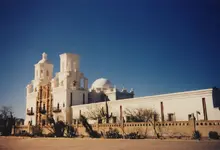







 >
>
 ] reasons for some of the treasure. Earlier in this thread there has been discussion that Loyola himself felt using such things helped 'make connections to the mystical dimension and symbolism of Catholicism'.
] reasons for some of the treasure. Earlier in this thread there has been discussion that Loyola himself felt using such things helped 'make connections to the mystical dimension and symbolism of Catholicism'.





